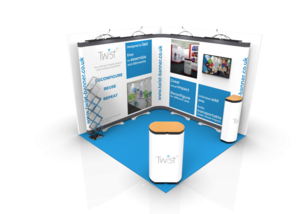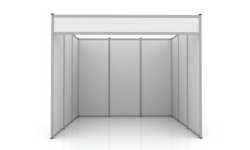Exhibiting Guide & Tips
EXHIBITION STAND TIPS & TRICKS
Exhibiting is an investment not just in terms of how much money you spend on the floor space and your exhibition stand but also in time, resources and effort. It's hard work. But exhibiting is also one of the most effective methods of face-to-face marketing. It's worth getting it right. With proper planning, promotion, stand staff training, follow up and measurement, the experience becomes enjoyable and the rewards great.
Exhibiting tips and advice from the London Display Company builds a complete resource of useful and practical information to give you the tools for successful and hassle-free exhibiting.
Read our FREE exhibiting tips and advice each month on this web page or sign up to receive them straight to your in-box!
- Setting exhibition goals and objectives
- Writing an exhibition plan
- Create an exhibition marketing budget
- Read the exhibitor manual
- What are you going to exhibit?
SETTING EXHIBITION GOALS AND OBJECTIVES
When you are deciding to exhibit you need to be certain that the exhibition you have chosen fits into your overall sales and marketing strategy.
Before you book your exhibition stand space, ask yourself the following questions:
- Why am I exhibiting at this show?
- What products/services will I be exhibiting?
- What do I want to accomplish?
- What will I be doing to achieve the results?
- What image do I want to project?
- How does this specific exhibition fit into my sales and marketing plan?
Your answers to these questions will help you form specific objectives that you need to establish to be a successful exhibitor. The objectives you set should be measurable and obtainable. You will find it much easier to measure and judge your success if you are specific with your objectives. For instance, you can set a specific number of show leads to generate, appointments to make, units to sell.
Your exhibition objectives can be as challenging as you want to make them, but remember you and your stand staff want to succeed, so be realistic, particularly if you’re exhibiting for the first time or setting show objectives for the first time.
There are 6 principle reasons why companies choose to exhibit:
- Build Sales
- Improve customer relationships
- Conduct market research
- Generate media relations/PR
- Build brand awareness
- Build and support sales channels
When you are setting your show objectives, consider each of the above to determine why you are going and what you want to achieve.
CAN THIS SHOW DELIVER ON YOUR OBJECTIVES?
To find out, get as much information as possible about the exhibition you're considering.
- Ask the show organisers for a copy of last year's registration form and an attendee profile. This will tell you who you'll meet on the show floor and will help you match your target audience to the expected visitor audience
- Ask for the names of other confirmed exhibitors, and search the list for your competitors
- Ask past exhibitors and attendees what they liked and disliked about the show, and whether it met their buying and selling needs
- Ask show management how they plan to promote the show, and what they will do to help your ideal prospect find you there
Select the exhibition because you believe it can deliver on your show objectives not because your sales team thinks you should be there or because the show organisers tell you your competitors are there.
Knowing exactly what you want is a necessary element of success. Make sure that you understand your objectives. Make them SMART:
- Specific
- Measurable
- Achievable
- Realistic
- Time-bound
WRITING AN EXHIBITION PLAN
Planning is a necessary part of success. Careful and meticulous planning of your exhibition is no exception. It’s easy to underestimate how long it takes to properly plan for an exhibition and therefore you should be starting 4 – 6 months ahead of the show. For some companies with larger exhibition stands and a more complicated exhibiting schedule, planning may need to start up to 12 months in advance.
It’s quite simple – planning for your exhibition makes life so much easier! And it can help you avoid additional expenses and last minute panics.
- Appoint an exhibition co-ordinator with overall responsibility
- Write an exhibition plan with key activities, dates and responsibilities
- Get everyone involved that needs to be – circulate a copy of the exhibition plan with responsibilities and then keep chasing them
- Stick to your deadlines
A written exhibition plan should provide:
- Objectives
- Time scales
- Budgets
- Space requirements
- Exhibition design parameters
- On-site services
- Transportation and logistics
- Staffing levels and training
- Pre- and post-show promotions
- Show evaluation criteria
- On-stand data capture
- Follow-up procedure for leads
Each part of the exhibition plan works together to create synergy and success.
CREATE AN EXHIBITION MARKETING BUDGET
Having an exhibition marketing budget focuses you to the actual cost of exhibiting and provides the basis for measuring and establishing your return on investment.
Make sure you don’t leave anything out and be aware that your budget can vary from show to show as your requirements change. If you haven’t set an exhibition marketing budget before, use the categories below as a guide:
Exhibition Stand Costs - Exhibition stand purchase or rental costs. Note: include refurbishing and/or expansion costs when budgeting for subsequent shows
Exhibition Design Graphics - Vinyl, large format, digital fabric signage and graphics, lightboxes etc
Exhibition - Exhibition stand space, shipping to and from the show, install and dismantling, electrics, flooring, carpet, furniture, audio visual, photography, stand cleaning and other specialist requirements like waste/water, internet or telephone
Stand Staff - Accommodation, travel, expenses, uniforms
Marketing - Pre-show, at-show and post-show direct mail/email marketing, pr and media relations, advertising, sponsorship, promotional giveaways, literature or customer hospitality
Add a 5% - 10% contingency to the total budget
READ THE EXHIBITOR MANUAL
Reading the exhibitor manual seems a logical and common sense thing to do – and yet so many exhibitors fail to do it. Why read it?
The exhibitor manual is full of all the information you need to know about participating at your chosen show. It contains all the rules and regulations, checklists, order forms for show services, marketing forms for free pr and pre-show support, contractor information, build up and break down schedules, accommodation and hospitality information, floor plans, exhibitor lists and registration details.
Many exhibition organisers use on-line manuals and you will be issued with a login and password to access the exhibitor part of the show website. Some will use a combination of an on-line zone and a printed manual. And some organisers only use a printed version. Check with your show organiser to find out when the manual will be available and in what format it will be provided.
Read the manual carefully and make sure you note the key dates for ordering contractor services such as electrics, waste and water, cleaning etc – if you miss the deadline you can expect a hefty surcharge.
Depending on the type of stand space you order there will be rules and regulations that you need to adhere to – these are detailed in the manual.
As soon as the manual arrives on your desk or in your in-box take the time to go through it – that’s the only way of making sure you know and can act on everything you need to.
WHAT ARE YOU GOING TO EXHIBIT?
As part of setting your exhibition objectives and writing your exhibition marketing plan, you need to decide what products and/or services you want/need to exhibit.
Avoid displaying every product you have to offer. Your message will become confused and so too will the visitors. Keep in your mind that you have 3 – 5 seconds to grab attention. During that time the visitor needs to notice your exhibition stand, understand what it is you are telling/showing them and decide to want to know more. Make it easy for them with clear, concise messaging.
If you are launching a new product, for example, your exhibition stand design needs to focus on the new product. Once you have the visitor’s attention, you can tell them about everything else you do.
Remember you have 3 – 5 seconds to grab attention. In that time you need to convey:
- Who you are
- What you sell
- The benefit of your product/service to them
Explore the Exhibition Range
We are exhibition stand specialists and can assist you in creating your perfect exhibition stand to any budget.
View More Case Studies
Posted by Samantha on September 21st 2021








